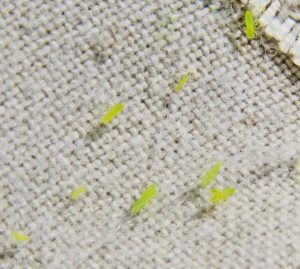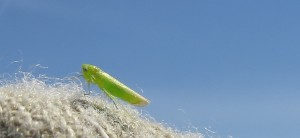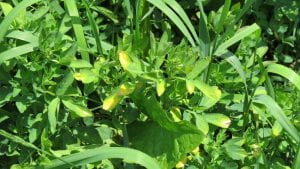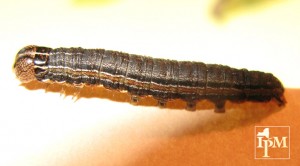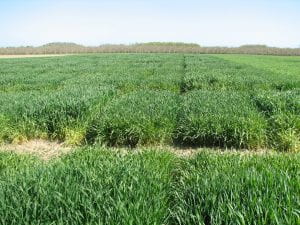Contents
View from the Field
Potato leafhopper
Potato leafhopper is on the rise. There was a range of reports from low infestations to over the economic threshold in alfalfa. Potato leafhopper really thrives under hot, dry conditions. For more information on potato leafhopper in alfalfa, please refer to the following video: IPM for Potato Leafhopper on Alfalfa
Western Bean Cutworm Trapping
Extension educators and crop consultants across the state are setting up western bean cutworm moth pheromone traps next to cornfields. This network monitors the flight of the moths to determine when you should get out and scout your corn for western bean cutworm damage. We will post statewide maps on the number of moths caught per trap each week and alert you to areas of the state with high moth catches. We have approximately 70 traps placed next to cornfields around the state. There will be more western bean cutworm information in the weeks to come!
Alfalfa weevil
Alfalfa weevil was reported at low levels this last week. Based on the degree-day models for alfalfa weevil they should be in cocoon stage now and not feeding on alfalfa until 2021!
True armyworm and Black Cutworm
True armyworm was reported at low levels in field corn this past week. Some areas of the state could still have issues with true armyworm, based on the degree-day modeling and when the flights occurred. There were no reports of black cutworm damage in fields.
Small Grain Diseases
There were several small grain diseases reported at low levels across the state this week. The following is a list of the diseases:
- Powdery mildew in wheat and barley
- Net blotch in barley
- Leaf rust in barley
- Barley Yellow Dwarf Virus
- Scald in barley
- Spot blotch in barley
- Stripe rust in wheat
- Oat crown rust
- Loose smut in barley
- Leaf rust in barley
- Fusarium head blight
Plant Locally Adapted Varieties and Hybrids
It’s important to stress the value of planting locally-adapted varieties and hybrids of whatever crop you grow. Not just for agronomic purposes (maturity, yield, etc.), but also for adequate pest and disease resistance. Reports of oat crown rust have been on varieties that aren’t well-adapted to our region. Many pathogens have various ‘races’, and these races are sometimes regional. A variety developed and marketed for production elsewhere in the US or Canada may not be a good choice for our races of foliar pathogens, like oat crown rust. The same goes for corn and soybean foliar diseases. Cornell provides annual summaries of the varieties they evaluate for small grains, forages, corn grain and corn silage.
Degree Days Base 50 F
From March 1, 2020 to June 28, 2020
| Station Location |
(Base 50) March 1 |
| Canton | 691 |
| Ceres | 644 |
| Chazy | 662 |
| Cobleskill | 655 |
| Geneva | 841 |
| Highland | 903 |
| Ithaca | 750 |
| Kinderhook | 871 |
| Malone | 641 |
| Massena | 660 |
| Oriskany Falls | 743 |
| Red Hook | 886 |
| Versailles | 778 |
| Watertown | 674 |
Black Cutworm and True Armyworm Degree Days
June 28, 2020
| *Location for Intense Catches |
Black Cutworm (Base 50) |
Life Stage | *Location for Intense Catches |
True Armyworm (Base 50) |
Life Stage |
| Seneca Falls 4/28/20 | 828 | Pupation |
Canajoharie 5/5/20 |
580 | Larval stages |
| Martinsburg 4/28/20 | 751 | Pupation |
Sauquoit 5/19/20 |
675 | Larval stages |
| Amenia 5/14/20 | 795 | Pupation |
Walton 5/19/20 |
555 | Larval stages |
|
Venice 5/19/20 |
738 | Pupation | Seneca Falls 4/28/20 | 828 | Larval stages |
|
Castile 5/5/20 |
734 | Pupation |
Avon 5/14/20 |
816 | Larval stages |
*Intense Catch is over 15 moths in a week.
Black Cutworm Degree Days (Base 500 F) Lifecycle Growth Stages
Degree Days Stage Feeding Activity
0 Moth Capture Egg Laying
90 Eggs Hatch
91-311 1st to 3rd Instar Leaf Feeding
312-364 4th Instar Cutting Begins
365-430 5th Instar Cutting Begins
431-640 6th Instar Cutting Slows
641-989 Pupa No feeding
Source: University of Minnesota Insect Pest of Corn-Stand Reducers Black Cutworm
True Armyworm Degree Days (Base 500 F) Lifecycle Growth Stages
Degree Days Stage Feeding Activity
0 Moth Capture Egg Laying
113 Eggs Hatch
612 Larval stages Leaf Feeding
909 Pupa No feeding
True armyworm insecticides registered in NYS for field crops
Clipboard Checklist
Keith Waldron, NYS IPM
General
*Walk fields to check general field condition, weed issues
*Watch for crop maturity, stand assessments, weed escapes, lodging issues
Alfalfa:
*Evaluate established legume stands for approximate days until harvest
*Monitor potato leafhopper
*Monitor new seedings for potato leafhopper, pythium blight, phytopthora root rot.
Small Grains:
*Monitor winter grain fields for growth stage, disease issues, cereal leaf beetle
*Check stands for diseases, cereal leaf beetle, weed escapes
*Monitor winter wheat and winter malting barley for signs of Fusarium Head Blight
*Monitor spring grains for potential risk of fungal diseases – consult Fusarium Head Blight prediction model
Corn:
*Conduct plant population assessments, early season corn pests including seed corn maggot, white grub, wireworm, black cutworm, armyworm, slugs, diseases, weed issues, vertebrate damage
Soybeans:
*Post emergence weed evaluation, timely cultivation and/or weed management
*Conduct plant population assessments, early season corn pests including seed corn maggot, slugs, soybean aphid, diseases, weed issues, vertebrate damage
Pasture:
*Check and mend fences as needed.
*Check crop growth
*Invasive species, plants harmful to livestock
*Review/Plan rotation system
Equipment:
*Remove / clean soil and crop debris from equipment
*Arrange for custom weed control or check your own application or cultivator equipment for repairs.
*Carry appropriate / necessary NYS DEC and EPA required documents: (pesticide applicators license, pesticide labels, MSDS sheets, etc.) with application equipment
*Calibrate:
- planting equipment – maintain records on planting rate per field
- manure spreaders – maintain records on amount spread per field
- pesticide application equipment – Check nozzles, pumps, etc., recalibrate pesticide application equipment before use. Maintain pesticide use records
Storage:
* Check stored grain bins for temperature, moisture and signs of mold and insects. Aerate, core, transfer grain or treat as necessary
*Check forage allocation and anticipate feed program adjustments as forages from previous year are used up
*Plan where forages should be stored for optimum allocation next feeding season
*Mow around storage bins and facility to minimize pest hiding places
Dairy Cattle Barn Fly Management:
*Monitor animals and barn area for house fly, stable fly and other pest management needs including presence of rodents and birds.
*Check facilities for favorable fly breeding conditions: (organic matter + moisture): leaks in watering systems, roof gutters for leaks and potential overspill, drainage,
*Sanitation, sanitation, sanitation – clean animal resting areas, feed troughs, minimize source of moist organic matter i.e. fly breeding areas in barn and in adjacent animal loafing yard
* Continue fly monitoring: install “3X5″ index card fly speck monitoring cards throughout barn
*Use, replenish, replace fly management materials: sticky fly tapes/ribbons, insecticide baits, natural enemies (parasitoids), fly population monitoring (3 x 5) spot cards
*Consider purchase and release of Muscidifurax raptor and/or M. raptorellus natural enemies of house and stable fly pupae.
Dairy Cattle on Pasture:
*Monitor animals for presence of face flies, horn flies and stable flies. Action guidelines: face flies (average 10 per animal face), horn flies (average 50 / dairy per animal side, 200 / beef cattle per animal side), stable flies average 10 per animal (all four legs)
*Check feed bunk / water source locations for signs of stable fly breeding (moist undisturbed organic matter – spilled feed, round bales, etc.), minimize source of moist organic matter i.e. fly breeding areas in barn and in adjacent animal exercise yard.
*Check pasture for forage quality / quantity, rotate as appropriate
*Check pasture for vegetation poisonous to livestock
*Consider use of pasture fly traps to help reduce deer, horse and stable fly populations


